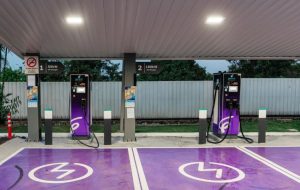One of the key aspects of digitalization is the integration of digital platforms like the Gentari Go app. This app empowers users with real-time information, seamless access to an extensive network of charging stations, and even the option to explore solar solutions for their homes. This digital connectivity simplifies the user experience and supports the broader goal of decarbonization, says Nikhil Thomas, Chief Executive Officer, Green Mobility, Gentari India in an interview with Anurima Mondal, Editor of EVolution Auto India.

Q: Gentari Green Mobility recently launched all-in-one Gentari Go EV charging app. Please tell us some interesting features of this app. How does it enable users to seamlessly access clean energy offerings, from home solar to green mobility solutions?
Nikhil Thomas: Gentari Go is a customer-centric platform designed to offer an integrated sustainable lifestyle by unifying Gentari’s clean energy ecosystem. Now activated in India, Gentari Go features green mobility and renewable energy solutions, positioning itself as the preferred sustainable lifestyle partner for consumers across the Asia Pacific region.
For Consumers:
- Seamless User Experience: The app provides a simple, elegant interface that guides first-time users through discovery, activation, and payment processes effortlessly. We have integrated advanced features like our charging curve, providing real-time insights into energy consumption during charging sessions.
- Household Solar: Partnering with HomeScape (an Amplus Solar initiative), Gentari offers users the opportunity to explore solar power solutions directly from the app, with 250+ channel partners across India to assist with home solar installation.
- Extensive EV Charging Network: Integration with various charging networks ensures comprehensive coverage, supporting the expansion of sustainable transportation and making it easier for drivers to travel across India in their EVs. Access up to 700 chargers across India.
- Rewards for Clean Energy: Gentari Go further reaffirms the value of embracing clean energy by rewarding consumers with incentives and redeeming points for using the platform and contributing to clean energy causes.
- EV Test Drive Option: For those who do not yet own an EV, Gentari Go offers an in-app booking option for test drives with one of the leading EV players in India, (coming soon).
For Businesses:
- Gentari Go for Business: enabling your business fleet allowing your company to unlock the full potential of Gentari Go. For companies with EV fleets, staff transport using EVs, drivers for senior leadership or corporate benefits for EV drivers, Gentari Go will give you the perfect tool to supercharge EV adoption in your organisation. It will help your organization’s EV drivers access a wider network of public chargers owned by Gentari and our roaming partners. In addition, our Vehicle as A Service customers can utilise Go for Business while leveraging telematic data for streamlined operations.
- For charging point operators – Seamless integration with our Roaming Hub awaits you right now to connect with our pipeline of B2C and B2B customers. And if you’re considering your own platform, we have a suite of solutions that we can tailor, and we’d love to talk to you about.
For car manufacturers and OEMs: Allow us to enhance your customer experience with exclusive features like AutoCharge, Plug&Charge, card payment terminals, in-car integration and Mini-App solutions.
Q: Could you shed some light on the comprehensive suite of EV charging solutions provided by Gentari? How do you see the role of electric vehicles evolving in the next decade?
Nikhil Thomas: At Gentari, we are committed to driving the transition to a zero-emission future by offering a comprehensive suite of EV charging solutions. The focus is on developing an extensive and reliable charging network that supports both consumers and businesses in their journey toward sustainable transportation.
Gentari’s Vehicle-as-a-Service (VaaS) model provides end-to-end EV fleet management. From understanding fleet requirements, offering comprehensive vehicle and charging solutions to vehicle deployment, we ensure a seamless experience. We work closely withthe clients as we manage fleet operations, including servicing, claims, and replacements, while addressing queries through our CRM system also offering flexibility in extending agreements or redeploying vehicles basis client’s requirements.
Electric vehicles (EVs) will play an increasingly central role in our global efforts to combat climate change. Over the next decade, we’ll see EVs become the norm, rather than the exception, with significant advancements in battery technology, infrastructure, and affordability. EVs will not only reduce our carbon footprint but also revolutionize the way we think about mobility—ushering in an era of cleaner and smarter transportation systems. At Gentari, we’re proud to be at the forefront of this ‘Evolution’, and we remain dedicated to providing the solutions that will drive this change.
Q: Earlier this year, Gentari joined hands with leading EV charging business solution provider Hubectas a platform partner to expand the EV charging network across Southeast Asia. Please tell us more about this collaboration.
Nikhil Thomas: We partnered with Hubject to advance Gentari Go’s regional roaming connectivity by collaborating with the world’s largest e-roaming platform with over 500,000 chargers connected worldwide. On top of this Hubject brings to us the ability to enable Plug & Charge capabilities for OEMs who would like to partner with us to provide customers a seamless charging experience.
In India we are proud to partner with Numocity who is helping us with our charger management system as well as connections to 10 great CPOs in India.
Q: How, according to you, is digitalization making the EV sector smarter and more efficient?
Nikhil Thomas: Digitalization is revolutionising the EV sector by driving efficiency and creating a smarter ecosystem. By integrating advanced digital technologies, we are enhancing the entire EV infrastructure, making green mobility more accessible and efficient for both consumers and businesses.
One of the key aspects of digitalization is the integration of digital platforms like the Gentari Go app. This app empowers users with real-time information, seamless access to an extensive network of charging stations, and even the option to explore solar solutions for their homes. This digital connectivity simplifies the user experience and supports the broader goal of decarbonization.
For businesses, the Gentari Go app is a powerful tool that can accelerate EV adoption within organisations. It provides companies with EV fleets, staff transport using EVs, and corporate benefits for EV drivers with access to a wide network of public chargers, including those owned by Gentari and our roaming partners. Our Vehicle as a Service (VaaS) customers can also utilize Gentari Go for Business, leveraging telematic data to streamline operations and optimize their EV fleet management.
For first-time EV users, the Gentari Go app simplifies their charging journey by effortlessly guiding them through discovery, activation, and payment processes. The app also includes advanced features such as a charging curve, which provides real-time insights into energy consumption during charging sessions. Additionally, our integration with various charging networks ensures comprehensive coverage, enabling drivers to travel across India in their EVs with ease.
Q: What are the key factors driving the growth of the EV industry in India?
Nikhil Thomas: The growth of the EV industry in India is being propelled by several key factors that align with both national priorities and global trends. With the government’s strong commitment to sustainability and reducing carbon emissions, a favorable policy environment for electric vehicles is being fostered. Initiatives such as the Faster Adoption and Manufacturing of Electric Vehicles (FAME) scheme, tax incentives, and infrastructure investments are playing a crucial role in accelerating EV adoption.
There is a growing awareness and demand for cleaner, more efficient transportation options among consumers and businesses alike. As the publicis becoming more conscious of their environmental footprint, the shift towards electric vehicles is seen not just as a choice, but as a responsibility.
Additionally, advancements in technology are making EVs more accessible and affordable. Improvements in battery technology, charging infrastructure, and the availability of EV models across different price segments are helping to break down barriers to adoption.
Lastly, the rise of innovative business models, such as Vehicle-as-a-Service (VaaS), is enabling a broader range of industries, from logistics to the gig economy, to integrate electric mobility into their operations. This, coupled with the support of industry players like Gentari, is driving the growth of the EV ecosystem in India, making it an increasingly viable and attractive option for consumers and businesses alike.
Q: The current Indian government has set a target of achieving 30 percent electric vehicle penetration by 2030. What are your views on the government policies and incentives? What additional measures could be taken by the government to boost the EV charging infrastructure?
Nikhil Thomas: Indian government’s target of achieving 30 percent electric vehicle (EV) penetration by 2030 is ambitious and well-aligned with global sustainability goals. The policies and incentives introduced so far, such as FAME II, the PLI Scheme for Advanced Chemistry Cell (ACC) Battery Storage, and the National Electric Mobility Mission Plan (NEMMP) 2020, have laid a solid foundation for accelerating EV adoption and reducing the nation’s dependence on fossil fuels.
These initiatives, combined with tax incentives on EV purchases and the Green Urban Transport Scheme, contribute to a more sustainable transportation ecosystem.
The introduction of the PM E-Drive Scheme, with a budget of Rs 10,900 crore, is a crucial step forward. This program, replacing FAME II, supports electric two-wheelers, three-wheelers, e-buses, and e-trucks, and aims to set up 88,500 charging sites across India. By prioritizing mass transport and two- and three-wheelers, the scheme ensures targeted support where EV adoption can have the most immediate and widespread impact. However, we had anticipated some incentives for four-wheelers as well to further accelerate adoption in that segment.

However, more can be done to scale up the EV infrastructure. Key suggestions include:
- Increased investment in charging infrastructure: Expanding fast-charging networks, especially in semi-urban and rural areas, would be critical for wider adoption. The current focus on urban centers should be complemented by initiatives to address under-served regions.
- Localized battery manufacturing and recycling: The PLI scheme for battery storage is a great start, but additional incentives to develop a domestic battery recycling industry can help reduce dependency on raw materials and minimize environmental impact.
- Demand aggregation for EVs in public transport: Extending subsidies and easing procurement barriers for state transport undertakings, as outlined in the PM E-Drive’s e-bus initiative, can ensure that more cities transition to electric public transport efficiently.
- Encouraging private investment: Streamlining policies that encourage public-private partnerships in EV infrastructure deployment could attract more capital into this growing sector.
These measures would complement existing policies and drive India closer to its target of 30 percent EV penetration by 2030.
Q: What are the current challenges facing the electric vehicle industry, and what strategies could be implemented to overcome them?
Nikhil Thomas: The electric vehicle industry in India has immense growth potential but faces significant challenges. One of the primary hurdles is the varying state regulations. The differing rules, permits, and compliance requirements across states complicate operations, adding to costs of EV providers and delays in expanding EV infrastructure.
Another challenge is the absence of a unified national policy framework. Without standardized regulations and incentives, it becomes difficult to plan long-term investments confidently. Grid connectivity and energy supply issues, governed by state utilities, further complicate reliable power delivery to charging stations.
To address these challenges, the industry actively engages with state governments to adapt to local regulations and advocate for a more consistent national regulatory framework. By collaborating with policymakers, we aim to standardize operations and foster a supportive environment for the EV industry. We have focused investing in innovative solutions for reliable grid connectivity and renewable energy sources, ensuring a resilient and sustainable charging network.